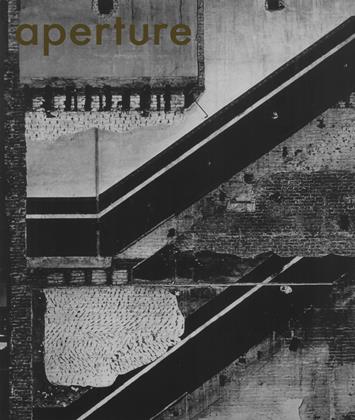IN-SECURITY: THE NUCLEAR DILEMMA
REVIEWS
For a person of my generation, it is impossible to be neutral about anything containing the word "nuclear." It conjures up the following images, all of which have entered that archive we might call "disaster nostalgia": Nikita Khrushchev banging his shoe on the UN tabletop, test buildings being dusted off the Nevada desert by a multi-megaton blast, missile-laden freighters steaming toward Cuba, children crouching under their school desks during attack drills, families stocking their fallout shelters. But it has been twenty-nine years since Three Mile Island and twenty-two since Chernobyl; today, Iran notwithstanding, the idea of a nuclear attack against a major power seems hard to fathom. More to the point, the price of oil has made everyone begin to forget why the N-word was so taboo.
There’s a perfect image of this forgetfulness in the exhibition In-Security: Le Dilemme Nucléaire/The Nuclear Dilemma, staged in the Musée international de la Croix-Rouge et du CroissantRouge in Geneva. In Jürgen Nefzger’s 2003 photograph of beachgoers frolicking in the sea near Penly, France, a massive nuclear power plant peeks just around the point. What’s the problem?
At the same time, many of the images by the ten photographers in the exhibition exert an aesthetic fascination that makes their impact ambiguous at best. Emmet Gowin is an environmentally committed image-maker, but his photographs of the nuclear test site craters in Nevada have the alien fascination of another planet, unrelated to ours. (Besides, we don’t do that anymore.) Nigel Green obtained privileged access to the now obsolete Dungeness B, Britain’s major nuclear facility, where his father had worked. Green’s riveting pictures look like something out of an Austin Powers movie: images of the future that was, astounding and comical.
In a brief introduction that reads like a defense, the curators assert that photographs can clarify and amplify other forms of scientific and political discourse that display a certain “opacity.” That is putting it mildly. This exhibition should have been accompanied by text panels displaying the official obfuscation and double-speak perfected by military strategists and industry apologists. But the issue here is the photographs, which keep putting us between a rock and a very hard place. To me the hard place is represented not by the many Chernobyl images, which, barring a miracle like cold fusion, we will have to learn to live with if we want more cheap energy. The real problem is represented, for example, by Tsuchida Hlromi’s ongoing project Remember Hiroshima, a photo-catalog of objects in the Hiroshima Memorial Peace Museum collected from the destroyed city, with accompanying narratives to explain them. To show more than the handful in the exhibition would have been too much for audiences to bear. Consider the image of Akio Tsukuda’s school uniform jacket, found hanging from the skeleton of a tree by his father
on August 8, 1945. No other trace of the boy was ever recovered. It recalls the line of the 1944 poem “Todesfuge” (“Deathfugue”) by Paul Celan: “Wir shaufeln ein Grab in den Lüften da liegt man nicht eng”: “We are digging a grave in the air there’s room for us all.”
The real nuclear dilemma is that there is no such thing as evil, only expediency, and because that lurks in all of us, it is very difficult to say “never again" about anything.©
Lyle Rexer
In-Security: Le Dilemme Nucléaire/The Nuclear Dilemma was presented at the Musée international de la CroixRouge et du Croissant-Rouge, Geneva, February 27July 27, 2008. The exhibition travels to the Fundación Museo de la Paz de Gernika, Spain, September 18, 2008-February 4, 2009.
 View Full Issue
View Full Issue
More From This Issue
-
 Portfolio
PortfolioRichard Misrach Untitled
Winter 2008 -
 Work And Process
Work And ProcessOn The Edge Of Clear Meanin
Winter 2008 By David Levi Strauss -
 Roads Less Traveled
Roads Less TraveledDisappearing Giants
Winter 2008 By Michael "Nick" Nichols -
 Witness
WitnessSusan Meiselas Nicaragua
Winter 2008 By John Berger -
 Essay
EssayDeep In The Archive
Winter 2008 By Ulrich Baer -
 Mixing The Media
Mixing The MediaThe Author As Photographer Early Soviet Writers And The Camera
Winter 2008 By Erika Wolf
Subscribers can unlock every article Aperture has ever published Subscribe Now
Lyle Rexer
-
 Work And Process
Work And ProcessSeeing Is Believing
Fall 2003 By Lyle Rexer -
 Reviews
ReviewsShomei Tomatsu: Skin Of The Nation
Spring 2005 By Lyle Rexer -
 Reviews
ReviewsThe Perfect Medium: Photography And The Occult
Winter 2005 By Lyle Rexer -
 Books
BooksHeinz Hajek-Halke: Artist, Anarchist
Fall 2007 By Lyle Rexer -
 Reviews
ReviewsHaunted: Contemporary Photography/video/performance
Winter 2010 By Lyle Rexer -
 Excerpts
ExcerptsPhotographs Not Taken: A Collection Of Photographers’ Essays Edited By Will Steacy
Fall 2012 By Lyle Rexer
Reviews
-
 Reviews
ReviewsWilliam Eggleston: Democratic Camera
Summer 2009 By Carlo McCormick -
 Reviews
ReviewsThe First Guangzhou Photo Biennial
Summer 2005 By Christopher Phillips -
 Reviews
ReviewsStrangers: The First Icp Triennial
Spring 2004 By Fred Ritchin -
 Reviews
ReviewsClick Doubleclick The Documentary Factor
Fall 2006 By Gerry Badger -
 Reviews
ReviewsAi Weiwei: Interlacing
Winter 2011 By Martin Jaeggi -
 Reviews
ReviewsCzech Photography Of The Twentieth Century
Winter 2009 By Noemi Smolik

